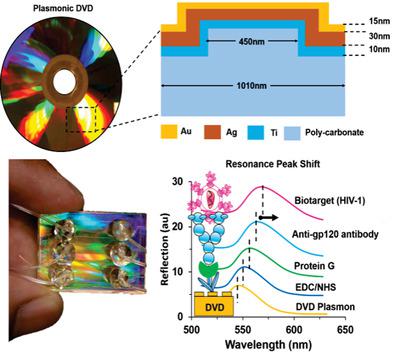当前位置:
X-MOL 学术
›
Adv. Mater.
›
论文详情
Our official English website, www.x-mol.net, welcomes your
feedback! (Note: you will need to create a separate account there.)
Tunable Fano-Resonant Metasurfaces on a Disposable Plastic-Template for Multimodal and Multiplex Biosensing.
Advanced Materials ( IF 27.4 ) Pub Date : 2020-03-23 , DOI: 10.1002/adma.201907160 Rajib Ahmed 1 , Mehmet Ozgun Ozen 1 , Merve Goksin Karaaslan 1 , Cecilia A Prator 2 , Cassandra Thanh 2 , Shreya Kumar 2 , Leonel Torres 2 , Nikita Iyer 2 , Sadie Munter 2 , Sarka Southern 3 , Timothy J Henrich 2 , Fatih Inci 1 , Utkan Demirci 1
Advanced Materials ( IF 27.4 ) Pub Date : 2020-03-23 , DOI: 10.1002/adma.201907160 Rajib Ahmed 1 , Mehmet Ozgun Ozen 1 , Merve Goksin Karaaslan 1 , Cecilia A Prator 2 , Cassandra Thanh 2 , Shreya Kumar 2 , Leonel Torres 2 , Nikita Iyer 2 , Sadie Munter 2 , Sarka Southern 3 , Timothy J Henrich 2 , Fatih Inci 1 , Utkan Demirci 1
Affiliation

|
Metasurfaces are engineered nanostructured interfaces that extend the photonic behavior of natural materials, and they spur many breakthroughs in multiple fields, including quantum optics, optoelectronics, and biosensing. Recent advances in metasurface nanofabrication enable precise manipulation of light-matter interactions at subwavelength scales. However, current fabrication methods are costly and time-consuming and have a small active area with low reproducibility due to limitations in lithography, where sensing nanosized rare biotargets requires a wide active surface area for efficient binding and detection. Here, a plastic-templated tunable metasurface with a large active area and periodic metal-dielectric layers to excite plasmonic Fano resonance transitions providing multimodal and multiplex sensing of small biotargets, such as proteins and viruses, is introduced. The tunable Fano resonance feature of the metasurface is enabled via chemical etching steps to manage nanoperiodicity of the plastic template decorated with plasmonic layers and surrounding dielectric medium. This metasurface integrated with microfluidics further enhances the light-matter interactions over a wide sensing area, extending data collection from 3D to 4D by tracking real-time biomolecular binding events. Overall, this work resolves cost- and complexity-related large-scale fabrication challenges and improves multilayer sensitivity of detection in biosensing applications.
中文翻译:

用于多模式和多重生物传感的一次性塑料模板上的可调谐法诺共振超表面。
超表面是工程化的纳米结构界面,可扩展天然材料的光子行为,并促进量子光学、光电子学和生物传感等多个领域的许多突破。超表面纳米加工的最新进展使得能够在亚波长尺度上精确操纵光与物质的相互作用。然而,由于光刻技术的限制,当前的制造方法成本高昂且耗时,并且活性面积小且再现性低,其中感测纳米级稀有生物靶标需要宽的活性表面积以进行有效的结合和检测。在这里,引入了一种塑料模板可调谐超表面,具有大的活性面积和周期性金属介电层,可激发等离子体 Fano 共振跃迁,提供对蛋白质和病毒等小型生物靶标的多模态和多重传感。超表面的可调谐法诺共振特征是通过化学蚀刻步骤实现的,以管理装饰有等离子体层和周围介电介质的塑料模板的纳米周期性。这种与微流体集成的超表面进一步增强了广泛传感区域内的光与物质相互作用,通过跟踪实时生物分子结合事件将数据收集从 3D 扩展到 4D。总体而言,这项工作解决了与成本和复杂性相关的大规模制造挑战,并提高了生物传感应用中多层检测的灵敏度。
更新日期:2020-03-23
中文翻译:

用于多模式和多重生物传感的一次性塑料模板上的可调谐法诺共振超表面。
超表面是工程化的纳米结构界面,可扩展天然材料的光子行为,并促进量子光学、光电子学和生物传感等多个领域的许多突破。超表面纳米加工的最新进展使得能够在亚波长尺度上精确操纵光与物质的相互作用。然而,由于光刻技术的限制,当前的制造方法成本高昂且耗时,并且活性面积小且再现性低,其中感测纳米级稀有生物靶标需要宽的活性表面积以进行有效的结合和检测。在这里,引入了一种塑料模板可调谐超表面,具有大的活性面积和周期性金属介电层,可激发等离子体 Fano 共振跃迁,提供对蛋白质和病毒等小型生物靶标的多模态和多重传感。超表面的可调谐法诺共振特征是通过化学蚀刻步骤实现的,以管理装饰有等离子体层和周围介电介质的塑料模板的纳米周期性。这种与微流体集成的超表面进一步增强了广泛传感区域内的光与物质相互作用,通过跟踪实时生物分子结合事件将数据收集从 3D 扩展到 4D。总体而言,这项工作解决了与成本和复杂性相关的大规模制造挑战,并提高了生物传感应用中多层检测的灵敏度。











































 京公网安备 11010802027423号
京公网安备 11010802027423号